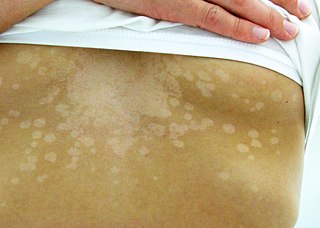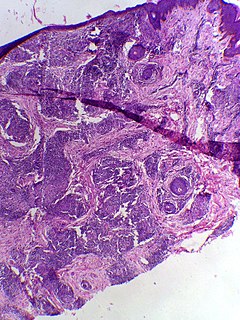| Borderline leprosy | |
|---|---|
| Specialty | Infectious disease |
Borderline leprosy is a cutaneous skin condition with numerous skin lesions that are red irregularly shaped plaques. [1] :345
| Borderline leprosy | |
|---|---|
| Specialty | Infectious disease |
Borderline leprosy is a cutaneous skin condition with numerous skin lesions that are red irregularly shaped plaques. [1] :345

Leprosy, also known as Hansen's disease (HD), is a long-term infection by the bacteria Mycobacterium leprae or Mycobacterium lepromatosis. Infection can lead to damage of the nerves, respiratory tract, skin, and eyes. This nerve damage may result in a lack of ability to feel pain, which can lead to the loss of parts of a person's extremities from repeated injuries or infection due to unnoticed wounds. An infected person may also experience muscle weakness and poor eyesight. Leprosy symptoms may begin within one year, but, for some people, symptoms may take 20 years or more to occur.

Tinea versicolor is a condition characterized by a skin eruption on the trunk and proximal extremities. The majority of tinea versicolor is caused by the fungus Malassezia globosa, although Malassezia furfur is responsible for a small number of cases. These yeasts are normally found on the human skin and become troublesome only under certain circumstances, such as a warm and humid environment, although the exact conditions that cause initiation of the disease process are poorly understood.

Mycobacterium leprae is a bacterium that causes leprosy, also known as "Hansen’s disease", which is a chronic infectious disease that damages the peripheral nerves and targets the skin, eyes, nose, and muscles. Leprosy can occur at all ages from infancy to elderly, but is curable in which treatments can avert disabilities. It was discovered in 1873 by the Norwegian physician Gerhard Armauer Hansen, who was searching for the bacteria in the skin nodules of patients with leprosy. It was the first bacterium to be identified as causing disease in humans.

Lupus vulgaris are painful cutaneous tuberculosis skin lesions with nodular appearance, most often on the face around the nose, eyelids, lips, cheeks, ears and neck. It is the most common Mycobacterium tuberculosis skin infection. The lesions may ultimately develop into disfiguring skin ulcers if left untreated.
Pityriasis alba is a skin condition, a type of dermatitis, commonly seen in children and young adults as dry, fine-scaled, pale patches on the face. It is self-limiting and usually only requires use of moisturizer creams.
Mycobacterium lepraemurium is a causative agent of feline leprosy. It causes granulomatous lesions, characteristic of the Mycobacterium genus.
The Fernandez reaction is a reaction that occurs to signal a positive result in the lepromin skin test for leprosy. The reaction occurs in the skin at the site of injection if the body possesses antibodies to the Dharmendra antigen, one of the antigens found in Mycobacterium leprae, the bacteria that causes leprosy. The reaction occurs via a delayed-type hypersensitivity mechanism. This reaction occurs within 48 hours of injection of lepromin and is seen in only tuberculoid forms of leprosy. In contrast, the Mitsuda reaction occurs 3-4 weeks after injection of lepromin and is only seen in patients with the tuberculoid form of leprosy. In terms of mechanism of action and appearance, the reaction is similar to the tuberculin reaction of a positive Mantoux test for tuberculosis.
A leprostatic agent is a drug that interferes with proliferation of the bacterium that causes leprosy.
Madarosis is a condition that results in the loss of eyelashes, and sometimes eyebrows. The term "madarosis" is derived from the ancient Greek "madaros", meaning "bald". It originally was a disease of only losing eyelashes but it currently is the loss of both eyelashes and eyebrows. Eyebrows and eyelashes are both important in the prevention of bacteria and other foreign objects from entering the eye. A majority of patients with madarosis have leprosy, and it was reported that 76% of patients with varying types of leprosy had madarosis.

Erythema dyschromicum perstans is an uncommon skin condition with peak age of onset being young adults, but it may also be seen in children or adults of any age. EDP is characterized by hyperpigmented macules that are ash-grey in color and may vary in size and shape. While agents such as certain medications, radiographic contrast, pesticides, infection with parasites, and HIV have been implicated in the occurrence of this disease, the cause of this skin disease remains unknown.

Acroosteolysis is resorption of the distal bony phalanges. Acroosteolysis has two patterns of resorption in adults: diffuse and bandlike.
Granuloma multiforme is a cutaneous condition most commonly seen in central Africa, and rarely elsewhere, characterized by skin lesions that are on the upper trunk and arms in sun-exposed areas. It may be confused with tuberculoid leprosy, with which it has clinical similarities. The condition was first noted by Gosset in the 1940s, but it was not until 1964 that Leiker coined the term to describe "a disease resembling leprosy" in his study in Nigeria.

Tuberculoid leprosy is a form of leprosy characterized by solitary skin lesions that are asymmetrically distributed with few lesions and well demarcated edges. There is also early and marked nerve damage. It tends to heal spontaneously. Tuberculoid leprosy is characterized by the formation of epithelioid cell granulomas with a large number of epithelioid cells. In this form of leprosy Mycobacterium leprae are either absent from the lesion or occur in very small numbers. This type of leprosy is the most benign and the least contagious.
Borderline tuberculoid leprosy is a cutaneous condition similar to tuberculoid leprosy except the skin lesions are smaller and more numerous.
Borderline lepromatous leprosy is a skin condition with numerous, symmetrical skin lesions.

Lepromatous leprosy is a form of leprosy characterized by pale macules in the skin.
Histoid leprosy is a skin condition, a rare form of multibacillary leprosy.

Jesus cleansing a leper is one of the miracles of Jesus. The story is found in all three of the Synoptic Gospels: Matthew 8:1–4, Mark 1:40–45 and Luke 5:12–16.
Lucio's phenomenon is an unusual reaction seen almost exclusively in patients from the Caribbean and Mexico with diffuse lepromatous leprosy, especially in untreated cases. It is characterised by recurrent crops of large, sharply demarcated, ulcerative lesions, affecting mainly the lower extremities, but may generalise and become fatal as a result of secondary bacterial infection and sepsis.
The diffuse leprosy of Lucio and Latapí, also known as diffuse lepromatous leprosy or "pretty leprosy" is a clinical variety of lepromatous leprosy. It was first described by Lucio and Alvarado in 1852 and re-identified by Latapí in 1936. It is common in Mexico and in Costa Rica and very rare in other countries.
| Classification |
|---|